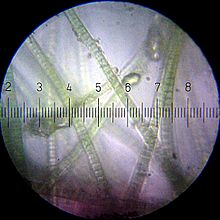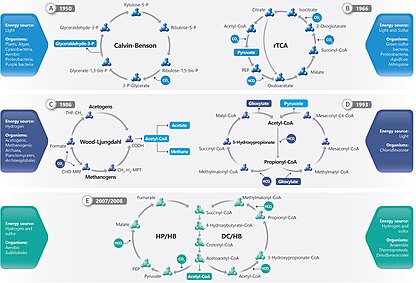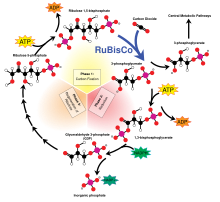Biological carbon fixation

Biological carbon fixation, or сarbon assimilation, is the process by which living organisms convert inorganic carbon (particularly carbon dioxide) to organic compounds. These organic compounds are then used to store energy and as structures for other biomolecules. Carbon is primarily fixed through photosynthesis, but some organisms use chemosynthesis in the absence of sunlight. Chemosynthesis is carbon fixation driven by chemical energy rather than from sunlight.
The process of biological carbon fixation plays a crucial role in the global carbon cycle, as it serves as the primary mechanism for removing CO2 (carbon dioxide) from the atmosphere and incorporating it into living biomass. The primary production of organic compounds allows carbon to enter the biosphere.[1] Carbon is considered essential for life as a base element for building organic compounds.[2] The element of carbon forms the bases biogeochemical cycles (or nutrient cycles) and drives communities of living organisms.[2] Understanding biological carbon fixation is essential for comprehending ecosystem dynamics, climate regulation, and the sustainability of life on Earth.[3]
Organisms that grow by fixing carbon, such as most
Six natural or autotrophic carbon fixation pathways are currently known. They are the: i)
Net vs. gross CO2 fixation

The primary form of fixed inorganic carbon is carbon dioxide (CO2). It is estimated that approximately 250 billion tons of carbon dioxide are converted by photosynthesis annually. The majority of the fixation occurs in terrestrial environments, especially the tropics. The gross amount of carbon dioxide fixed is much larger since approximately 40% is consumed by respiration following photosynthesis.[5][6] Historically, it is estimated that approximately 2×1011 billion tons of carbon has been fixed since the origin of life.[7]
Overview of pathways

Six autotrophic carbon fixation pathways are known:[8] the Calvin Cycle, the Reverse Krebs Cycle, the reductive acetyl-CoA, the 3-HP bicycle, the 3-HP/4-HB cycle, and the DC/4-HB cycles.
The organisms the Calvin cycle is found in are plants, algae, cyanobacteria, aerobic proteobacteria, and purple bacteria.[1] The Calvin cycle fixes carbon in the chloroplasts of plants and algae, and in the cyanobacteria. It also fixes carbon in the anoxygenic photosynthesis in one type of Pseudomonadota called purple bacteria, and in some non-phototrophic Pseudomonadota.[9]
Of the other autotrophic pathways, two are known only in
List of pathways

Calvin cycle
The Calvin cycle accounts for 90% of biological carbon fixation. Consuming adenosine triphosphate (ATP) and nicotinamide adenine dinucleotide phosphate (NADPH), the Calvin cycle in plants accounts for the predominance of carbon fixation on land. In algae and cyanobacteria, it accounts for the dominance of carbon fixation in the oceans. The Calvin cycle converts carbon dioxide into sugar, as triose phosphate (TP), which is glyceraldehyde 3-phosphate (GAP) together with dihydroxyacetone phosphate (DHAP):[11]
- 3 CO2 + 12 e− + 12 H+ + Pi → TP + 4 H2O
An alternative perspective accounts for NADPH (source of e−) and ATP:
- 3 CO2 + 6 NADPH + 6 H+ + 9 ATP + 5 H2O → TP + 6 NADP+ + 9 ADP + 8 Pi
The formula for inorganic phosphate (Pi) is HOPO32− + 2H+. Formulas for triose and TP are C2H3O2-CH2OH and C2H3O2-CH2OPO32− + 2H+

Reverse Krebs cycle
The
The cycle involves the biosynthesis of acetyl-CoA from two molecules of CO2.[16] The key steps of the reverse Krebs cycle are:
- Oxaloacetate to malate, using NADH + H+
- Fumarate to succinate, catalyzed by an oxidoreductase, Fumarate reductase
- Succinate to succinyl-CoA, an ATP-dependent step
- Succinyl-CoA to alpha-ketoglutarate, using one molecule of CO2
- Alpha-ketoglutarate to isocitrate, using NADPH + H+ and another molecule of CO2
- ATP citrate lyase
This pathway is cyclic due to the regeneration of the oxaloacetate.[17]
The bacteria

Reductive acetyl CoA pathway
The reductive acetyl CoA pathway (CoA) pathway, also known as the Wood-Ljungdahl pathway uses CO2 as electron acceptor and carbon source, and H2 as an electron donor to form acetic acid.[19] This metabolism is wide spread within the phylum Bacillota, especially in the Clostridia.[20]
The pathway is also used by methanogens, which are mainly Euryarchaeota, and several anaerobic chemolithoautotrophs, such as sulfate-reducing bacteria and archaea. It is probably performed also by the Brocadiales, an order of Planctomycetota that oxidize ammonia in anaerobic condition.[16] [20][21] Hydrogenotrophic methanogenesis, which is only found in certain archaea and accounts for 80% of global methanogenesis, is also based on the reductive acetyl CoA pathway.
The Carbon Monoxide Dehydrogenase/Acetyl-CoA Synthase is the oxygen-sensitive enzyme that permits the reduction of CO2 to CO and the synthesis of acetyl-CoA in several reactions.[22]
One branch of this pathway, the methyl branch, is similar but non-homologous between bacteria and archaea. In this branch happens the reduction of CO2 to a methyl residue bound to a cofactor. The intermediates are formate for bacteria and formyl-methanofuran for archaea, and also the carriers, tetrahydrofolate and tetrahydropterins respectively in bacteria and archaea, are different, such as the enzymes forming the cofactor-bound methyl group.[16]
Otherwise, the carbonyl branch is homologous between the two domains and consists of the reduction of another molecule of CO2 to a carbonyl residue bound to an enzyme, catalyzed by the CO dehydrogenase/acetyl-CoA synthase. This key enzyme is also the catalyst for the formation of acetyl-CoA starting from the products of the previous reactions, the methyl and the carbonyl residues.[22]
This carbon fixation pathway requires only one molecule of ATP for the production of one molecule of pyruvate, which makes this process one of the main choice for chemolithoautotrophs limited in energy and living in anaerobic conditions.[16]
3-Hydroxypropionate [3-HP] bicycle
The 3-Hydroxypropionate bicycle, also known as 3-HP/malyl-CoA cycle, discovered only in 1989, is utilized by green non-sulfur phototrophs of Chloroflexaceae family, including the maximum exponent of this family Chloroflexus auranticus by which this way was discovered and demonstrated.[23] The 3-Hydroxipropionate bicycle is composed of two cycles and the name of this way comes from the 3-Hydroxyporopionate which corresponds to an intermediate characteristic of it.

The first cycle is a way of synthesis of

In the second cycle, glyoxylate is approximately one equivalent of propionyl-CoA forming methylamalonyl-CoA. This, in turn, is then converted through a series of reactions into citramalyl-CoA. The citramalyl-CoA is split into pyruvate and Acetyl-CoA thanks to the enzyme MMC lyase. At this point the pyruvate is released, while the Acetyl-CoA is reused and carboxylated again at Malonyl-CoA thus reconstituting the cycle.[26]
A total of 19 reactions are involved in 3-hydroxypropionate bicycle and 13 multifunctional enzymes are used. The multifunctionality of these enzymes is an important feature of this pathway which thus allows the fixation of three bicarbonate molecules.[26]
It is a very expensive pathway: 7 ATP molecules are used for the synthesis of the new pyruvate and 3 ATP for the phosphate triose.[25]
An important characteristic of this cycle is that it allows the co-assimilation of numerous compounds making it suitable for the mixotrophic organisms.[25]
A variant of the 3-hydroxypropionate cycle was found to operate in the aerobic extreme thermoacidophile archaeon Metallosphaera sedula. This pathway is called the 3-hydroxypropionate/4-hydroxybutyrate (3-HP/4-HB) cycle.[27]
Yet another variant of the 3-hydroxypropionate cycle is the dicarboxylate/4-hydroxybutyrate (DC/4-HB) cycle. It was discovered in anaerobic archaea. It was proposed in 2008 for the hyperthermophile archeon Ignicoccus hospitalis.[28]
enoyl-CoA carboxylases/reductases
CO2 fixation is catalyzed by enoyl-CoA carboxylases/reductases.[29]
Non-autotrophic pathways
Although no heterotrophs use carbon dioxide in biosynthesis, some carbon dioxide is incorporated in their metabolism.[30] Notably pyruvate carboxylase consumes carbon dioxide (as bicarbonate ions) as part of gluconeogenesis, and carbon dioxide is consumed in various anaplerotic reactions.
6-phosphogluconate dehydrogenase catalyzes the reductive carboxylation of ribulose 5-phosphate to 6-phosphogluconate in E. coli under elevated CO2 concentrations.[31]
Carbon isotope discrimination
Some
and also in assessing the possible or likely sources of carbon in global carbon cycle studies.Biological carbon fixation in soils
In addition to photosynthetic and chemosynthetic processes, biological carbon fixation occurs in soil through the activity of microorganisms, such as bacteria and fungi. These soil microbes play a crucial role in the global carbon cycle by sequestering carbon from decomposed organic matter and recycling it back into the soil, thereby contributing to soil fertility and ecosystem productivity. [35]
In soil environments, organic matter derived from dead plant and animal material undergoes decomposition, a process carried out by a diverse community of microorganisms. During decomposition, complex organic compounds are broken down into simpler molecules by the action of enzymes produced by bacteria, fungi, and other soil organisms. As organic matter is decomposed, carbon is released in various forms, including carbon dioxide (CO2) and dissolved organic carbon (DOC).
However, not all of the carbon released during decomposition is immediately lost to the atmosphere; a significant portion is retained in the soil through processes collectively known as soil carbon sequestration. Soil microbes, particularly bacteria and fungi, play a pivotal role in this process by incorporating decomposed organic carbon into their biomass or by facilitating the formation of stable organic compounds, such as humus and soil organic matter.[36]
One key mechanism by which soil microbes sequester carbon is through the process of microbial biomass production. Bacteria and fungi assimilate carbon from decomposed organic matter into their cellular structures as they grow and reproduce. This microbial biomass serves as a reservoir for stored carbon in the soil, effectively sequestering carbon from the atmosphere.
Additionally, soil microbes contribute to the formation of stable soil organic matter through the synthesis of extracellular polymers, enzymes, and other biochemical compounds. These substances help bind soil particles together, forming aggregates that protect organic carbon from microbial decomposition and physical erosion. Over time, these aggregates accumulate in the soil, resulting in the formation of soil organic matter, which can persist for centuries to millennia.
The sequestration of carbon in soil not only helps mitigate the accumulation of atmospheric CO2 and mitigate
Biological carbon fixation is a fundamental process that sustains life on Earth by regulating atmospheric CO2 levels, supporting the growth of plants and other photosynthetic organisms, and maintaining ecological balance.
See also
References
- ^ ISSN 2090-1232.
- ^ ISSN 2090-1232.
- )
- S2CID 41335311.
- S2CID 41335311.
- ISBN 978-0-12-227050-5, retrieved 2021-03-21
- S2CID 263839383.
- ISSN 2090-1232.
- ^
Swan BK, Martinez-Garcia M, Preston CM, Sczyrba A, Woyke T, Lamy D, et al. (September 2011). "Potential for chemolithoautotrophy among ubiquitous bacteria lineages in the dark ocean". Science. 333 (6047): 1296–300. S2CID 206533092.
- ISBN 978-0-12-373944-5.
- ISSN 1573-5079.
- PMID 21740227.
- PMID 18987310.
- PMID 18987310.
- .
- ^ S2CID 44800487.
- S2CID 2753977.
- S2CID 45745396.
- PMID 19575555.
- ^ S2CID 24050060.
- S2CID 4402553.
- ^ PMID 6436811.
- PMID 8354269.
- PMID 12374834.
- ^ PMID 21216907.
- ^ PMID 19955419.
- S2CID 13218676.
- ^
Huber H, Gallenberger M, Jahn U, Eylert E, Berg IA, Kockelkorn D, et al. (June 2008). "A dicarboxylate/4-hydroxybutyrate autotrophic carbon assimilation cycle in the hyperthermophilic Archaeum Ignicoccus hospitalis". Proceedings of the National Academy of Sciences of the United States of America. 105 (22): 7851–6. PMID 18511565.
- PMID 27856910.
- ^ Nicole Kresge, Robert D. Simoni, Robert L. Hill (2005). "The Discovery of Heterotrophic Carbon Dioxide Fixation by Harland G. Wood". The Journal of Biological Chemistry. 280 (18): e15.
- PMID 33199707.
- PMID 24992022.
- S2CID 12988287.
- S2CID 451126.
- )
- )
Further reading
- Keeling PJ (October 2004). "Diversity and evolutionary history of plastids and their hosts". American Journal of Botany. 91 (10): 1481–93. S2CID 17522125.
- Keeling PJ (2009). "Chromalveolates and the evolution of plastids by secondary endosymbiosis" (PDF). The Journal of Eukaryotic Microbiology. 56 (1): 1–8. S2CID 34259721. Archived from the original(PDF) on 9 July 2009.
- Keeling PJ (March 2010). "The endosymbiotic origin, diversification and fate of plastids". Philosophical Transactions of the Royal Society of London. Series B, Biological Sciences. 365 (1541): 729–48. PMID 20124341.
- Timme RE, Bachvaroff TR, Delwiche CF (2012). "Broad phylogenomic sampling and the sister lineage of land plants". PLOS ONE. 7 (1): e29696. PMID 22253761.
- Spiegel FW (February 2012). "Evolution. Contemplating the first Plantae". Science. 335 (6070): 809–10. S2CID 36584136.
- Price DC, Chan CX, Yoon HS, Yang EC, Qiu H, Weber AP, et al. (February 2012). "Cyanophora paradoxa genome elucidates origin of photosynthesis in algae and plants" (PDF). Science. 335 (6070): 843–7. S2CID 17190180. Archived from the original(PDF) on 14 May 2013.







